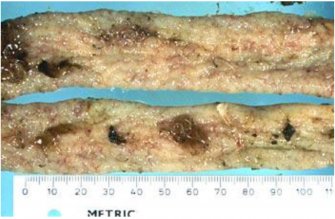These are white worms 30–60 mm long found in the blind gut (caecum) of the sheep and goats. The anterior part of their body is long and slender, while the posterior part is much thicker and curled in the male. Whipworm occurs in all sheep and goat production areas of Australia.
The larvae develop to third stage inside the eggshell. When the dung pellet becomes moist and disintegrates, the larvae (still in the egg shell) are released onto the soil surface. Stock grazing close to the soil surface ingest the larvae contained within the eggshell. They are very resistant to desiccation and freezing.
Whipworm are considered harmless except in very heavy infections.
Further ecological information on worms and their control:
The blind gut (caecum).

The only accurate way to diagnose worm infections before productivity losses have occurred is to conduct a WormTest (worm egg count). The results allow you to make the best choice of drench for the situation.
Visual signs only occur after significant production loss has already occurred. Also, these signs can occur with other parasites and diseases.
The worms are also easily identified during post-mortem examination. Also, whipworm has a very distinctive egg and is readily identified during worm egg counts.
There are many options to treat for this worm and your choice will depend on:
Your decision can be assisted by using the Drench Decision Guide, a simple tool that considers some of the points above.
You can also review the Drench pages on this site to find out specific information about drenches, including their drench active, drench group, length of protection, which worms they treat, dose rate, withholding period, export slaughter interval and manufacturer.
Note: only a few drench types are registered for use in goats.
The negative impact of this worm can also be reduced through browsing and grazing management strategies and by using one of the integrated worm control programs that have been developed for different regions across Australia.
All broad-spectrum drenches are effective against whipworms in the caecum. No drench resistance has been reported.